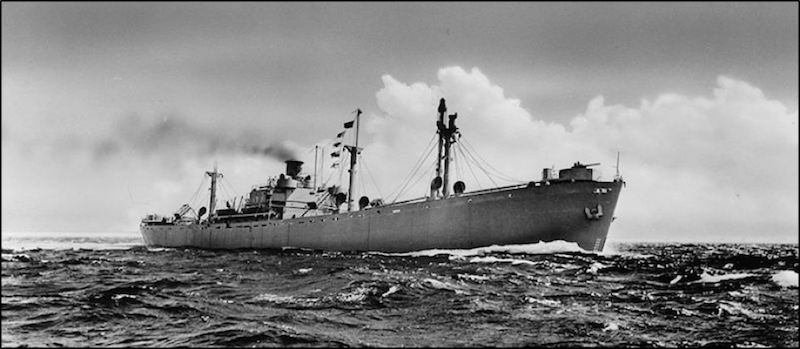
Wartime secrecy meant that the public knew little of the impact on merchant vessels by enemy submarines during WWII. But Japanese (and to a lesser extent German) submarines had significant successes operating along the east coast of Australia. Today we know that nineteen ships were sunk by torpedoes, shells or mines off the NSW coast during 1942-1944. A further 10 were damaged but managed to limp into port for repairs. Approximately 150 crew were killed in these attacks and the wreck sites today can form war graves.
The steel 'Liberty' ship William Dawes was one such vessel, sunk in sensational circumstances near Tathra in 1942. These mass-produced bulk cargo freighters were constructed in American purpose-built yards during WWII. Some 2,751 Liberty ships were built - the fastest in under five days.
The vessel
William Dawes (Official Number 89056) was built and registered in Portland, Oregon, USA, by the Oregon Shipbuilding Corporation. The two-decked vessel had a tonnage of 7176 tons gross, a cruiser stern and length of 126.8 metres (416 feet). It was powered by a triple expansion engine and operated as a United States Army Transport (USAT).
The William Dawes was laid down on 26 October 1942 and completed in three months and 12 days. Liberty ships were frequently named after important US citizens, with William Dawes being a revolutionary patriot in the American War of Independence who famously rode with Paul Revere in 1775.
Wreck event
William Dawes was on US wartime convoy duty operating alone along the New South Wales south coast when it was struck by a torpedo near Tathra. The vessel was destined for the Pacific theatre and perhaps New Caledonia. It had departed Adelaide on 19 July, with a stop planned for Sydney and Brisbane. Under command of Captain Froberg, cargo included ammunition, army stores, 82 quarter-ton jeeps, 72 half-ton pickups, 60 one-ton trailers, 14 cargo trucks, 12 ambulances, 12 half-track vehicles and 33 half-ton CPR's.
The terrifying attack occurred at 5.30 am on 22 July 1942 about 12-miles out to sea. The attacking submarine was a Japanese Imperial Navy submarine known as I-11. It had already torpedoed the George S. Livanos (20 July 1942) and the Coast Farmer (21 July), near Jervis Bay.
The first torpedo struck the stern which later separated. A second torpedo slammed into the hull amidships and started fires that eventually raged throughout the entire hull. Witnesses recalled the entire deck cargo of jeeps and lorries on fire and described the interior of the stern section “like a furnace”. 'Abandon ship' was ordered and the serviceable lifeboats launched. Keen to observe the damage, the massive dark grey bulk of the Japanese submarine surfaced close by, then slowly submerged!
The William Dawes finally sank at about 4.30 p.m., stern first. Five lives were lost in the action including one US army soldier and four Naval Armed Guards.
The next day (23 July), the steamer Allara was torpedoed by another Japanese submarine near Newcastle, but recovered.
Locals gallant rescue
The Merimbula Police coordinated a rescue operation by trawler operators, using vessels like Lass, to tow in the William Dawes lifeboats. The wounded were treated locally.
Source: environment.nsw.gov

